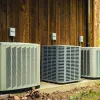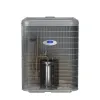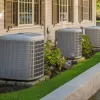More homeowners are installing mini-split heat pumps, and that’s a good thing. Not only are mini-splits more efficient than typical air conditioning systems, they’re also extremely practical for home additions, outbuildings, and even troublesome rooms that never seem to be hot or cool enough.
But as neat as mini splits are, they’re still, you know… HVAC systems. They can break down.
During the summer, we often get calls from Mitsubishi mini-split owners with units that have stopped cooling. Here’s a step-by-step process for fixing this problem and minimizing its recurrence down the line.
1. Troubleshoot the problem yourself.
Sometimes, there’s nothing wrong with your mini-split. You just need to do some basic troubleshooting to fix the problem. Here are some steps you can take:
Check the thermostat batteries. They might be dead. Pop in some new ones, and your AC should start right up.
Reset the circuit breaker. Head over to the breaker box and see if any of the breakers have tripped. If one has, check for shorts in the wiring connected to that circuit. If there aren’t any shorts, set the breaker back into place. Your mini-split might start working again. If the breaker keeps tripping, consider whether other devices or equipment are connected to the same circuit as the mini-split.
Check for ice on the coil. The system can shut off if airflow is so restricted that ice forms on the AC coil. In most cases, ice on the coil means it’s well past the time you changed your air filter. If there’s ice on the coil even though the air filter is clean, you may have other problems that require an HVAC professional.
Is the Mitsubishi unit still not cooling after you completed these troubleshooting tasks? Now’s the time to call a pro.
2. Find a Mitsubishi factory-endorsed contractor and place a service call.
Repairing a Mitsubishi mini-split heat pump isn’t the same as repairing a typical ducted heating and air conditioning system. You need to find a contractor with a working knowledge of the equipment and the components involved.
Most importantly, you need to find an HVAC contractor that has attained Mitsubishi Diamond Contractor or Ductless Pro status.
Why choose a factory-endorsed contractor? Because they’ve received special training on how to design, install, and commission Mitsubishi mini-split air conditioners and heat pumps.
These contractors have technicians on staff who have completed Mitsubishi’s training classes at the Mitsubishi factory. That’s a big deal. Whether you’re using a Mitsubishi ductless mini-split or a ducted mini-split unit, your system has a unique design and operation that an untrained contractor is going to struggle with.
We know this because we’ve completed the training.
And if we hadn’t completed the training, we wouldn’t be qualified to service these systems. It’s easy to find a Mitsubishi-approved contractor to install or service your mini-split. Just head on over to Mitsubishi’s contractor search tool and enter your zip code.
3. Ask about the contractor’s experience… and connections.
Being a factory-endorsed contractor is a minimum requirement. After you’ve narrowed your search down to just those companies or individuals, you need to find out how long they’ve been servicing Mitsubishi equipment.
The more Mitsubishi mini splits a contractor has repaired, the better. At PV Heating, Cooling & Plumbing, we’ve been installing and repairing Mitsubishi heat pumps for well over a decade. Our technicians’ combined experience spans several decades.
As you may have guessed, one benefit to choosing an experienced contractor is the greater amount of hands-on time versus less experienced counterparts. Aside from that, there’s another Mitsubishi-specific issue that any HVAC contractor will need to contend with when servicing your mini-split: the service manuals.
Mitsubishi’s manuals are written much differently than those produced by domestic HVAC equipment manufacturers.
All else being equal, a Trane manual is going to read a lot like a Carrier manual which will, in turn, read a lot like a Lennox manual. For most central HVAC systems, one manufacturer’s installation and service literature are going to look a lot like the material published by all the others.
With Mitsubishi, it’s a bit different.
For one thing, you have to choose the right manual out of all the ones available.
Unless you’ve been properly trained, this might take you a while. Once you find the right manual and the right page for addressing your problem, there’s often a lot less detail than you might expect if you’re used to domestic manufacturers’ manuals. It’s another reason why special training and experience are so important!
Another advantage has to do with connections. Throughout our tenure servicing Mitsubishi mini-split systems, we’ve enjoyed fantastic support from the Mitsubishi HVAC design team in Suwanee, Georgia, which happens to be within our service area.
Mitsubishi systems are complex and can throw curveballs at even the most experienced, highly trained contractors. Having a direct line to a local Mitsubishi team saves homeowners (and contractors!) valuable time when it comes to finding the best solution to their problems.
Did we mention that these guidelines apply during winter, too?
That’s right! Unless your Mitsubishi mini split only provides air conditioning, you may have the opposite problem during the winter: no heat. When that’s the case, follow the same protocol listed above.
You will get your mini-split working again. It’s all about finding the right contractor for the job.






